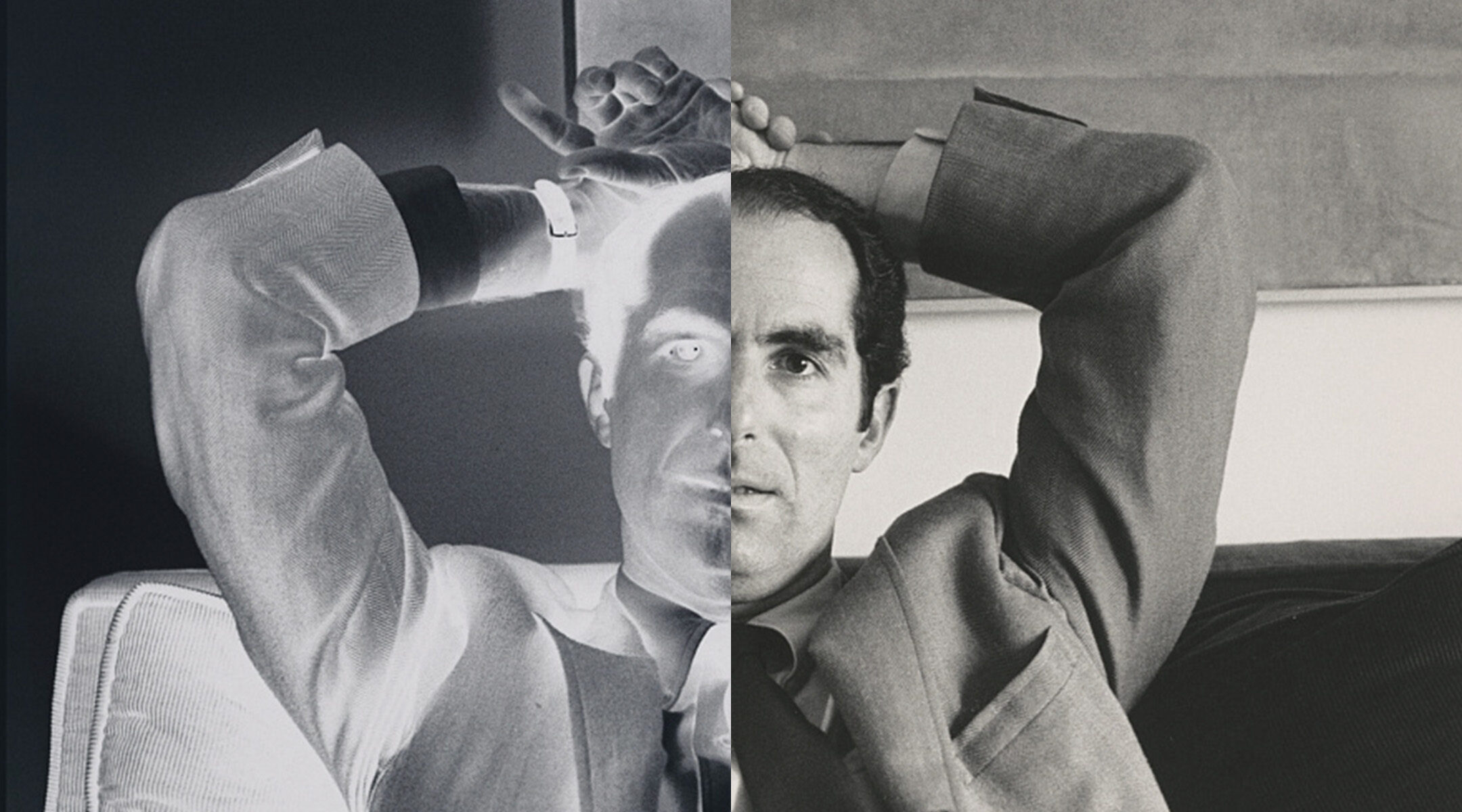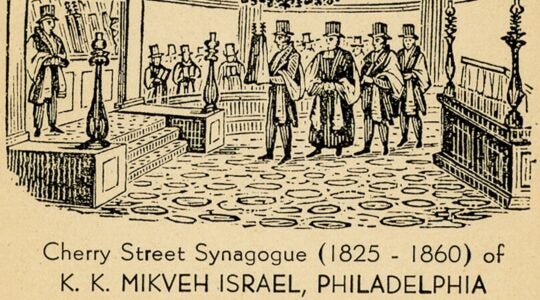(JTA) — Next Sunday marks the 90th anniversary of Philip Roth’s birth. In celebration of the famed novelist’s work, a scholarly conference titled “Roth@90,” sponsored by the Philip Roth Society, will be held starting Wednesday at the Newark Public Library. That will be followed by a weekend of high-profile events — staged readings, panel discussions, a bus tour of Roth’s old Newark neighborhood — co-presented by the library and the New Jersey Performing Arts Center.
Exactly 10 years ago, we commemorated his 80th birthday in a similar fashion. Dozens of Roth scholars made learned presentations about his work, of which Roth attended exactly zero. Later that week, the author read aloud from his novel “Sabbath’s Theater” in front of hundreds of fans, friends and well wishers. The proceedings were televised on C-Span.
Roth was being acclaimed for having just wound down an exemplary career. With the exception of the Nobel Prize, what garland evaded him? Was there a high-culture literary platform where his name wasn’t a virtual watermark? Could he publish any novel without hundreds of reviews being written in newspapers across the world? Was there a serious fiction writer out there with greater renown?
So much has changed in the decade between the two conferences. To begin with, Roth died in 2018. In that same span, the country witnessed the election of Donald Trump and the fissure it exposed in society in general and the Jewish community in particular. America endured one convulsive racial reckoning after another. Finally, in October of 2017, the #MeToo movement gained massive public salience.
All of those events, along with digital media’s indomitable ascent, have combined to affect and reshape Roth’s literary legacy. That legacy is far less assured than all the (justified) praise and lionizing that will occur this week might suggest.
Let’s start with Jews. The Trump era yielded two seemingly irreconcilable data points. On the one hand, Jewish-Americans endured the Charlottesville riot, the Tree of Life synagogue attack and a stunning rise in antisemitic incidents. On the other, there was staunch support for Trump among Orthodox Jews and supporters of Israel’s right wing.
Leaving that conundrum for others to parse, I simply note that Orthodox Jews and right-wing Zionists are almost completely absent in Roth’s fiction. A young Roth wrote a sensitive portrait of Holocaust survivors who want to start a suburban yeshiva in “Eli the Fanatic.” He also sketched a militant religious-nationalist Zionist in “The Counterlife,” Mordecai Lippman, who, according to Roth biographer Blake Bailey (about whom more below), was based on Elyakim Haetzni, one of the so-called founding fathers of the settlement movement. In the same novel, a version of the narrator’s brother falls under the settlement leader’s sway.
And that’s it, across a half century of writing. For traditionalist Jewish readers, whose political and social influence in the United States and Israel is substantial and growing, Roth’s fiction is not a mirror, nor a signpost, nor a scroll upon which is inscribed some essential truth.
The Jews who populated his stories, the Jews he best understood, were of Ashkenazi descent, white, liberal, assimilated and secular. His courage was to valorize them over and against other Jews who viewed them as defective, lost or even as apostates. Thus Anne Frank in “The Ghost Writer” was portrayed as a patron saint of secular Judaism. Elsewhere, his stories abound in proud, professionally accomplished diaspora Jews. They rarely think about God. Synagogue attendance is reserved strictly for lifecycle events and High Holy Days, if that.
A novelist, of course, is not a political clairvoyant. However, the immediate future of Judaism is being greatly shaped by Jews whose population and influence are growing and whom Roth rarely portrayed. In this manner, another stellar writer like Cynthia Ozick — herself Orthodox and quite attuned to the mindset of her co-religionists — might fare better commercially and emerge as more relevant than her friend in the coming decades.
Roth didn’t just write about Jews. In my book “The Philip Roth We Don’t Know: Sex, Race and Autobiography,” I pointed out that depicting non-Jewish Black people was an unrecognized “obsessional theme” across his 28 novels and 25 short stories. Much to my dismay, I found Roth’s multi-decade treatment of his African and African-American characters often to be crude, thoughtless and sometimes racist.
Familiarize yourself with the degrading portraiture we receive of Black people in “The Great American Novel” (1973), or a short story like “On the Air” (1970), and you might reconsider what Roth was after in “The Human Stain,” in which an academic who is accused of racism turns out to be an African American who had been “passing” as white and Jewish. The book, the 2001 Pen/Faulkner Award winner, is often seen as a sensitive treatment of racial issues in America, and perhaps as the author’s attempt to extend the hand of friendship to another oppressed minority.
In fact, my best guess is that, as with many Jewish writers post-1967, Roth was shaken by the deterioration of the Black-Jewish alliance. His frustrations were reflected in prose that often referenced Black communities in his hometown of Newark but showed little curiosity about their lives or sympathy for their plight.
Obviously, this type of literary rendering of African Americans — or any minority group — is disturbing and dated. Insensitive racial representation inspires calls for publishers to drop authors. They disappear from high-school or college syllabi. This bodes ominously for the afterlives of the titans of post-World War II American fiction, including John Updike, Saul Bellow and Norman Mailer, all three of whom have been accused of being racially insensitive and worse.
Roth’s marketability also seems to be sailing into a squall regarding gender. As women began demanding an accounting of sexual abuse and misogyny within the media, entertainment and other industries, numerous think-pieces wondered how the author of “Portnoy’s Complaint” — whose libidinous narrator identifies most of the women in his life by debasing nicknames — would fare in such an environment. Would he — should he — be “canceled”?
The question is more complex than his admirers and detractors make it out to be. No doubt, many of Roth’s male characters mistreated women. Accusations of Roth himself doing the same exist, but they are fairly rare, unsubstantiated and contested. The dilemma for researchers is that Roth was a deeply auto-fictional writer. You sense his presence in his stories — especially when protagonists share much of his biography, including Nathan Zuckerman and Peter Tarnopol, and when characters are named “Philip Roth.”
It’s hard not to speculate about the relation between the author and the many misogynistic fellows who cut an erotic swath through his pages. There will, of course, be readers who give him the benefit of the doubt. They might observe that Roth’s toxic males provide evidence of women’s experiences that needs to be explored, not censored.
Not helping him cleanse his reputation were the numerous allegations of sexual misconduct leveled against his hand-picked biographer, Blake Bailey. The ructions engulfing Bailey came to dominate the discourse about Roth, leading to a peculiar cancellation by proxy.
The episode also revealed that Roth had instructed his estate to eventually destroy a massive trove of personal papers he entrusted to Bailey. This led Aimee Pozorski (co-editor of Philip Roth Studies), myself and 20 other Roth scholars to issue a statement reminding his executors that “scholarship can only be advanced when qualified researchers engage freely with essential sources.”
As if all these concerns weren’t enough, his grim prophecies about the demise of an audience for serious literature seem to be coming true. “The book,” Roth worried, “can’t compete with the screen.” Meanwhile, the English major is in a very bad way, and the institution of tenure is under siege. Professors (insufferable as we might be) teach the next generation who to read and how to read. Writers might not like them, but they need them.
Roth is also getting the scrutiny that he was at pains to avoid in his lifetime. His disregard for scholars who might be critical of him always struck me, one such scholar, as misguided. Instead, he surrounded himself with friends — friends who had preternatural access to major media platforms. These friends built upon his own interpretations of his own work. It doesn’t mean they lacked wisdom. It just means that when they talked about Roth, they talked about what Roth wanted them to talk about. To wit: Jewish Newark, his sundry interpretations of his life, his pesky ex-wives and lovers, the close-mindedness of his critics, and so forth.
I think, in this cultural moment, it’s prudent to confront Roth’s limitations head on and chart one’s own path through his fiction. I pitch him to my students as a writer with some racial, religious and sexual hang-ups — who among us is innocent of those charges? I also present him as a bearer of unique and meaningful insights. Let scholars (while they still exist) parade those insights into sunlight.
I’ve tried to illuminate that his fiction was preoccupied, for 50 years, by how individual and collective bodies (like the Jews) change. Transformation, metamorphosis, metempsychosis — his obsession with those themes, I’ve noticed in my classrooms, is shared by Gen Z. If the span between Roth@80 and Roth@90 has taught us anything, it is that Roth was right: Life is about radical, unpredictable flux. Now his own legacy is in flux. I wonder who will read Roth@100.
JTA has documented Jewish history in real-time for over a century. Keep our journalism strong by joining us in supporting independent, award-winning reporting.







